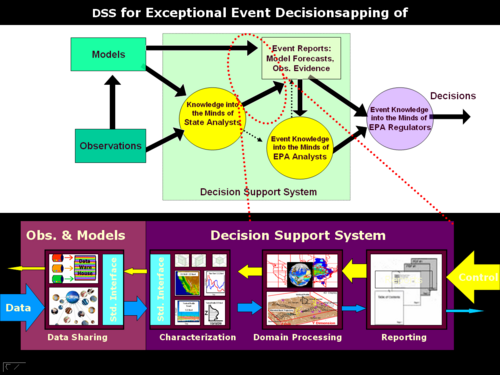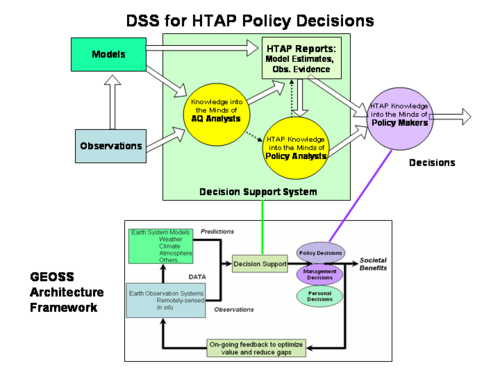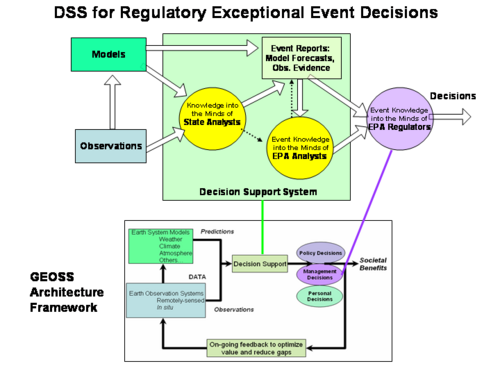On Decision-Support System Architectures
Beyond qualitative information, air quality managers need more quantitative data and analyses to justify their decisions and actions. Such support is provided by the decision support system.
A typical air quality decision support system consists of several active participants: The models and the observations are interpreted by experienced Technical Analysts who summarize their findings in 'just in time’ reports. Often these reports are also evaluated and augmented by Regulatory Analysts who then inform the decision-making managers. With actionable knowledge in hand, decision makers act in response to the pollution situation.
While the arrows indicate unidirectional flow of information, each interaction generally involves considerable iteration. For example, analysts explore and choose from numerous candidate datasets. Also most reports are finalized after considerable feedback.
Note that the key users of formal information systems are the technical analysts. Hence, the system needs to be tailored primarily to the analysts needs.
The decision support system for hemispheric transport assessment performs both model to model comparison as well as model to observation comparison.
The reports of analyses are submitted to policy analysts in the hemispheric transport Task Force.
The policy makers decide whether and in what way hemispheric pollutant transport should be included in International Long-Range Transport Protocols.
In case of natural exceptional pollution events, such as forest fire smoke the air quality analysts are typically affiliated with the impacted states.
They submit their reports to the federal EPA as part of their request for exceptional event waivers.
EPA analysts review the requests and make their recommendations to the EPA regulatory decision makers
In this case, the DSS needs to support both state and the federal analysts.
Traditional air quality information systems provide end-to-end solutions through dedicated ‘Stovepipe’ processing streams
However, many formerly closed data systems are now opening up and they share their data – through DataFed or other mediators
In a federated approach data are homogenized and augmented with services and tools streams…
The federated resources in turn can be fed back into individual project processing streams
The transition from the stovepipe to the networked, service oriented architecture can be gradual and non-disruptive.
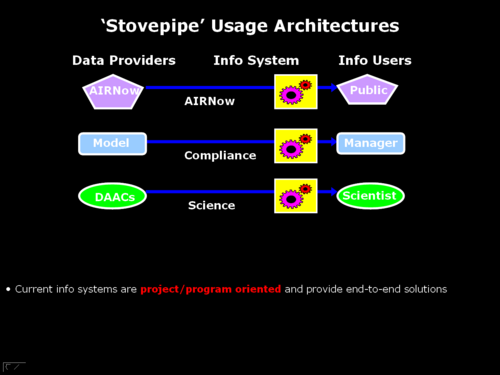
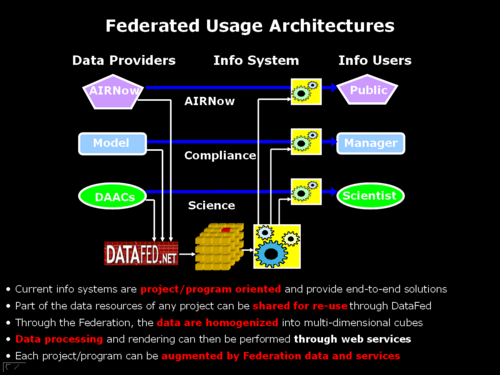
The intensely human decision system for air quality management can and needs to be augmented by computer and communication facilities.
Matching the mechanical support system to the human user needs is an art that is difficult to master.
This figure represents an attempt to relate the human and machine-executed processes, represented by arrows.
The first stage includes data access. Standardized data access services such as the OGC standards reduce the impediments and improves the agility of the system.
Turning models and observations into informing or scientific knowledge is the next step. This step begins with characterization.
The second stage of analysis entails transforming the general knowledge into application specific, actionable knowledge.
As the information flows from left to right, the nature of processing shifts from machine to human dominated processors.
